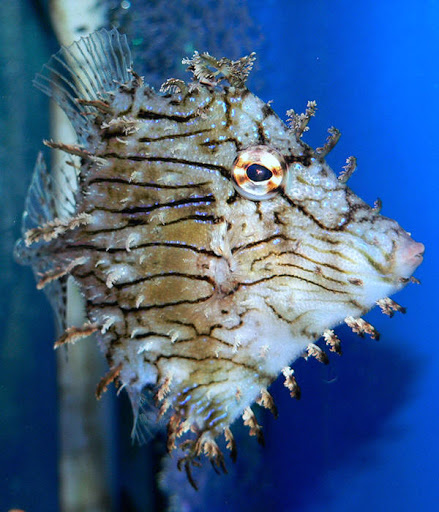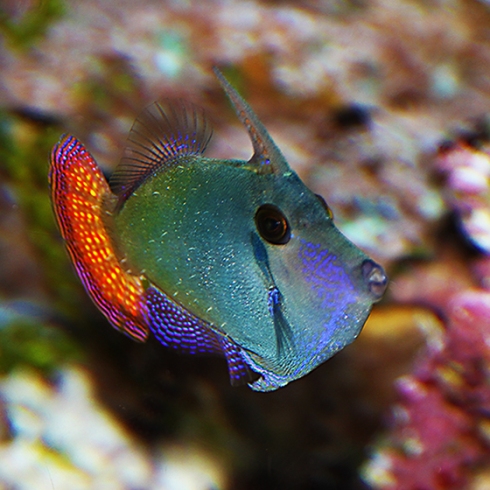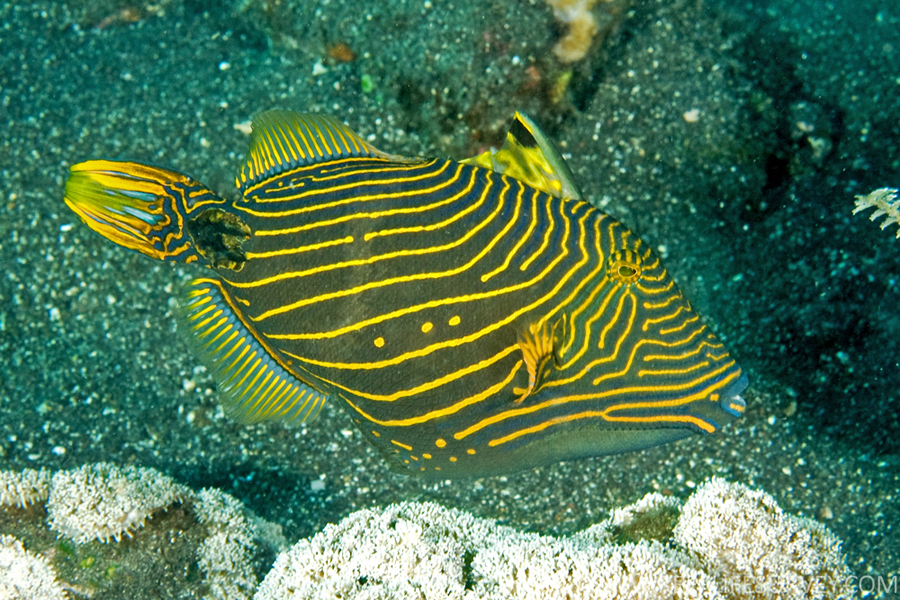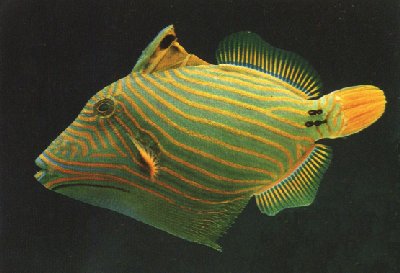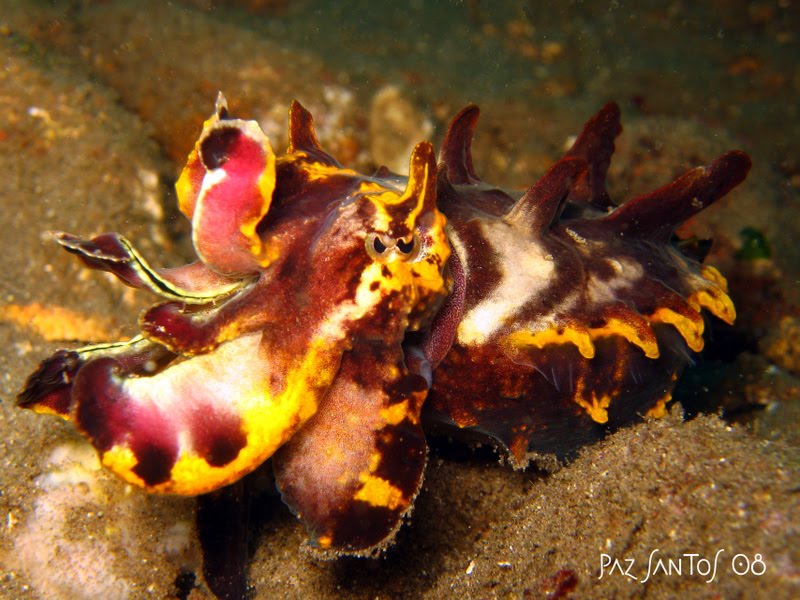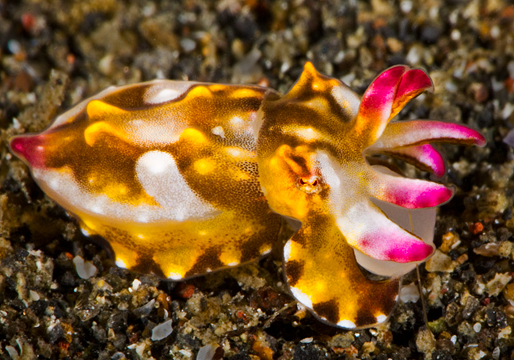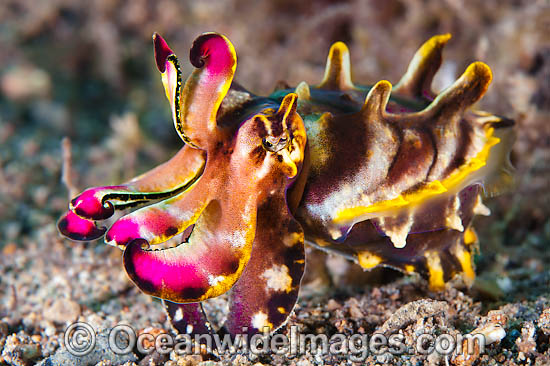You are currently browsing the tag archive for the ‘Indo-Pacific’ tag.

Meleager, the mythological hero who slew the Caledonian boar was famously accursed by fate, but beloved by ancient Greek artists and poets. As it turns out, this fixation outlived the ancient classical era. In the modern world, the matchless hunter is now beloved by taxonomists and biologists! Not only are turkeys and guineafowl both named after the Caledonian prince, but one of the strangest and most peculiar looking fish from the strange and peculiar order Tetraodontiformes is also named for poor Meleager.

Behold the guineafowl pufferfish, Arothron meleagris, a fish which lives in tropical waters of the Indian and Pacific oceans. This solitary puffer browses on corals and other suchlike invertebrates of the reef. Although they can grow up to half a meter (20 inches in length) and can swim very precisely and maneuver nimbly they are not strong swimmers, nor are they especially camouflaged (although their strange outline and spotted bodies help them blend in). If it really gets in trouble though, Arothron meleagris is a pufferfish and they can expand into a disconcerting spherical scary face which seems much larger than the fish itself.

Each of those chic spots is not just a dot but also a coarse bump, so they are further protected by a kind of sandpapery armor. Interestingly, guineafowl pufferfish come in three color varieties, deep purple brown with white spots, yellow with black spots, and a piebald mixture of yellow & dark brown with both black and white spots. Accounts vary as to whether the fish change color as they go through life or whether different specimens belong to one of the three types for life. Although I feel that Meleager’s name is suitably tragic for any fish in our dying oceans (particularly coral reef fish like the guineafowl puffer which are simultaneously hunter and hunted), tracing how the fish got the name involves a transitive leap. In mythology, Meleager was killed by his own mother after slaying his uncle in a quarrel (she used a sort of dark magic and was so horrorstruck that she immediately died herself). Meleager’s sisters were so consumed by cacophonous weeping that the gods took pity on them (???) and turned the women into guineafowl. Guineafowl are named after Meleager because of their strange lachrymose wails, however they are also spotted and stippled. Ichthyologists named the fish after the bird because both share white spots on a dark brown background (we will overlook the gold form for present).

Yet even if they got their name through a roundabout way, there is something anguished and otherworldly in the countenance of the guineafowl pufferfish which speaks to me of the odd popeyed expressions of tragic masks. Perhaps I will let this fish’s looks do the talking on behalf of Earth’s oceans today.


It has been far too long since we posted a spectacular tetraodontiform fish (my favorite order!). Therefore, as a special Monday treat, let us bask in the prickly protrusions of Chaetodermis penicilligerus, AKA the prickly leather-jacket. This filefish lives in a wide swath of tropical ocean from the east coast of Africa all the way to the islands of the Central Pacific. The prickly leather jacket grows up to 31 cm (1 foot) in length and eats all manner of small marine algae and tiny invertebrates.

The body of this fish acts as a sort of marine ghillie suit–obscuring the contours of the fish to hide it from predators and prey alike. The more famous leafy sea dragon has a similar modus operandi, but as a seahorse it lacks the filefish’s indomitable spirit (which you can maybe glimpse even in these digital images if you look into its angry, prickly eyes).

Today we head to the other side of the world to check out a very special mollusk— the black lip oyster (Pinctada margaritifera). This oyster is a suspension feeder which thrives in tropical coral seas amidst the colorful darting fish, exquisite anemones, and amazing biodiversity of reef life. The black lip oyster lives from the Persian Gulf, throughout the northern Indian Ocean across the IndoPacific divide up to Japan and around the islands of Micronesia, and Polynesia. However it is not the oyster’s (enviable) lifestyle that makes it famous, but what it produces –Tahitian pearls aka black pearls.


Tahitian pearls are one of the four great categories of cultured pearls. They occur in a rainbow variety of colors but mostly are charcoal, silver, or dark green with an iridescent sheen of green, purple, silver, blue, or gold. Since the black lip oyster is an exceedingly large mollusk, which can grow to weight of more than 4 kilograms (8-10 pounds), it can produce a capacious harvest of cultured pearls and can also produce extremely large pearls. The name black pearls is evocative and poetic and descriptive (since the pearls are dark), however true black Tahitian pearls are rare and precious.


When I was growing up in southwest Ohio, far from the beach, I remember encountering all sorts of stories concerning black pearls–thrilling tales of pearl divers, pirates, mermaid, giant Manta rays and such-like exoticism of a past era–however seemingly the internet, globalized commerce, and industrial aquaculture have taken some of the luster from these bright dreams (or do preadolescents still have feverish conversations about black pearls?). Maybe that was all because of the eighties and that decades taste for the darkly exotic and colorful….yet whatever the tastes and tides of fashion, I still find black pearls remarkably beautiful, and I would like to seek out some crowns and myths for you to adorn Ferrebeekeeper’s mollusk category. Hopefully I can avoid being cursed by a manta ray spirit (which, in retrospect, sounds beautiful and gentle)…but I promise nothing!

Filefish (Monacanthidae) are members of the order Tetraodontiformes, a group of fish which also includes sunfish, triggerfish, boxfish, and pufferfish. I am immensely fond of these sorts of fish because of their personality and appearance. Today we are going to look at a genus of filefish, the Pervagor, which are remarkable for their beautiful colors. Pervagor filefish are native to the Indian and Pacific oceans, where they live in shallow coastal waters and reefs. Like other filefish they feed on small invertebrates and other little animals which they catch. They evade predators with somewhat armor-like skeletons and with a pop-up spike on the top of their body (which they can use to wedge themselves into crevices—or simply to prevent being easily swallowed. I am writing about them not because of their remarkable lives (indeed I fave found it hard to find out many details about them) but because of their beautiful appearance. Each species is like a little piece of jewelry or a brilliant abstract painting. They are exactly what we need to get through the start of this week!

Pervagor janthinosoma (by Hiroshi Senoh for the National Museum of Nature and Science, Kanagawa Prefectual Museum of Natural History)
Just look at ’em! Evolution is such a mad artist that one is never disappointed by its never-ending improvisations, its dazzling palette, and obsessive use of form!
Today we bask in the tropical glory of a brilliantly colored (albeit temperamental) fish from my favorite family of fish, the Balistidae. This is the orange-lined triggerfish (Balistapus undulates). This aggressive reef fish is the only member of its genus (possibly because it attacked and destroyed all of its relatives). It lives throughout the tropical waters of the Indo-Pacific with all manner of horrifying sharks, marine crocodiles, and fishing humans, but it seems to care little and is noted not just for its extravagant color but also for its brash highly territorial character.
The orange-lined triggerfish is an omnivore. It mostly eats invertebrates such as mollusks, sponges, echinoderms, and corals (the fish crunches off the rocklike coral tips with its fearsome beak—which it also uses to bite through mollusk shells) but, when the opportunity arises it also eats marine algae and other fish. When it takes bites out of divers it is probably defending its territory and not expanding its diet. Triggerfish have eyes which move independently of each other so they can keep track of everything going on in their lively reef habitats. For the same reason, they have excellent color vision. They are long-lived and clever. Different individuals have different personalities and habits.
The fish is green with brilliant orange stripes and orange/yellow translucent fins. It grows to 30 centimeters (1 foot) long. Like other triggerfish, it has a powerful erectile spine in its dorsal fin. This spine lies in a groove in the fish’s body but can be locked in place when the fish is threatened. If the fish is in open water this means that a predator must swallow a nasty spike, but if the triggerfish is near coral or rocks (which it nearly always is) it can wedge itself beneath and then lock itself inextricably in place. A predator must try to pull the triggerfish out while contending with the sharp beak.
Woodblock prints of ages past show giant octopuses ripping apart boats and feasting on sailors like popcorn. These artifacts of ancient sea-lore make for rousing images, but they are quite wrong: octopuses are fierce and cunning hunters but they present little danger to humans—with a noteworthy exception. The truly dangerous octopuses are not giant monsters (perhaps the artists of yesteryear were thinking of the mighty giant squid?) but rather tiny jewel-like beauties from the genus Hapalochlaena which includes only three or four species. Known as blue-ring octopuses the tiny creatures swim in tide pools and shallows of the Indo-Pacific Ocean from Japan down to Australia (where they are most prevalent). Blue-ringed octopuses live on shrimp, crabs, minnows, and horseshoe crabs. They are tremendous hunters who use camouflage, stealth, and guile to catch their prey. However, these tools pale before their greatest weapon: the little octopuses are among the most poisonous creatures on planet Earth.
Like the flamboyant cuttlefish, the blue-ringed octopus does not like to bite without giving warning but advertises its toxicity with vivid coloration. The octopus can conceal itself with tremendous prowess however, as soon as it becomes aware of a predator or some other threat, it dials up its coloration changing from muted reef tones to brilliant yellow with iridescent blue rings. If you see something like this in the ocean, for heaven’s sake don’t touch it. The octopus’s warning colors let ocean predators know to leave it alone but immediately attract humankind’s magpie urge to grab shiny things. Although blue-ringed octopuses are good natured and have been known not to bite people who were provoking them rather intensely, their bites have caused more than seventy recorded fatalities in Australia. The octopus has a tiny beak and often a victim does not realize they have been bitten until they began to fall into paralysis and their respiration starts to fail.
The venom of the blue ringed octopus is a complicated pharmacological cocktail which includes tetrodotoxin, 5-hydroxytryptamine, hyaluronidase, tyramine, histamine, tryptamine, octopamine, taurine, acetylcholine, and dopamine. The most active ingredient tetrodotoxin blocks the sodium channels which conducting sodium ions (Na+) through a cell’s plasma membrane. This causes total paralysis for the octopus victim, however if clever and persistent rescuers are present at the time of the bite they can rescue the unfortunate soul with continuous artificial respiration. This is no small matter as bite victims are often rendered completely unresponsive by the paralytic victim. Although completely conscious they are unable to communicate in any way or even breathe. If artificial respiration is initiated immediately and continued until the body can metabolize and eliminate the toxin, bite victims can survive (although it sounds like rather an ordeal).
Blue ringed octopuses are tender and solicitous mothers. The mother octopus lays a clutch of approximately 50 eggs in autumn which she incubates beneath her arms for about six months (during which time she is unable to eat). When the eggs hatch, the mother octopus dies. The baby octopuses reach sexual maturity in about a year. Despite their cleverness and beauty, the animals are as ephemeral as they are deadly.
There are about 120 living species of marine mammals (although that total may tragically become much smaller in the very near future). Of this number, only one species is herbivorous. The mighty dugong (Dugong dugon) is the last animal of its kind, a gentle lumbering remnant of the giant herds of sirenian grazers which once graced the world’s oceans. Dugongs are distinct from the three extant species of manatees (the world’s other remaining sirenians) in that they never require fresh water at any point of their lives. Additionally dugongs possess fluked tails in the manner of dolphins and whales.
Dugongs live in shallow tropical waters of the Indian Ocean and the Pacific Ocean. They range from Madagascar to the Philippines, but are only common along the north coast of Australia (where conservation efforts and a limited human population have allowed them to live in peace). Dugongs can swim in deep oceans for a limited time, but prefer to stay on continental shelves where they can feed on seagrass and marine algae. Their all-salad diet does not prevent them from growing to substantial size: some individuals have been known to reach more than 3.5 meters in length (11 feet) and weigh over 950 kilograms (nearly a ton). Although Dugongs can live more than seventy years, they reproduce extremely slowly. Females gestate for over a year and then suckle their calf for around 18 months. Calves may stay with their mothers for many years after being weaned and need almost contact with their mothers for security and affection until they are almost grown. Young dugongs swim with their short paddle-like flippers, but adults use their tail for propulsion and only steer with their flippers.
Dugongs have a variety of vocalizations with which they communicate. Usually they live in small family units. Great herds are not unknown but seagrasses do not grow in sufficient quantity to support such numbers together for long.
Like the other sirenians, Dugongs have dense bones with almost no marrow (a feature known as pachyostosis). It has been speculated that such heavy skeletons help them stay suspended just beneath the water in the manner of ballast. The lungs of dugongs are extremely elongated, as are their large elaborate kidneys (which must cope with only saltwater). Additionally, the blood of dugongs clots extremely rapidly.
Dugongs face a number of natural threats, particularly storms, parasites, and illnesses. Because of their large size they are only preyed upon by alpha predators such as large sharks, killer whales, and salt-water crocodiles. As with other marine animals, the greatest dangers facing dugongs come from humankind. For millennia Dugongs have been hunted for meat, oil, and ivory. Traditional medicine from various portions of their range (wrongly) imputes magical properties to parts of their bodies. Worst of all, dugongs are frequent victims of boat collisions or are killed as by-catch by fishermen trying to catch something else.
One of the most delicate and exquisite shells of the world belongs to the Venus Comb Murex (Murex pectin) a predatory snail which hunts in the tropical waters of the Indo-Pacific. The snail is covered by over one hundred tapered spines which protect it from predators and support the creature (in the fashion of a snowshoe) when it traverses soft muds. The Venus Comb Murex hunts small mollusks, tunicates, worms, and crustaceans. When one handles the delicate 15 cm long shell it is strange to imagine that it belonged to a fearsome hunter. The Venus Comb Murex is a member of the Murexes, medium to large gastropods within the family Muricidae. Murexes were described by Aristotle–who used the exact same name for them.

